Native advertising: what you need to know

Native advertising is quickly becoming the advertising method of choice for e-commerce businesses. Native ads not only receive 53 percent more views than traditional display ads, but have found they increase purchase intent by 18%.
For many businesses, both e-comm and otherwise, the switch to native advertising is crucial in continuing to reach current customers and potential customers and engage with them in a meaningful way.
Content Marketing V. Native Advertising
A misconception about native advertising is that it’s the same as content marketing. Although similar, native advertising and content marketing are more like cousins than siblings in the marketing family. Both utilize content that is useful and interesting to a particular audience, but the difference lies in how the content is shared. Content marketing is content created by the brand, for the brand, or for an unpaid placement on a third-party channel.
Native advertising, on the other hand, is content that’s a paid placement for a third-party site. The majority of native advertising will be marked as such to separate it from editorial, whether it’s listed as “sponsored”, or set apart by different colors, fonts or placement within the site. It’s clear that the placement has been purchased, but it is usually integrated with non-purchased content in a seamless way.
Native Ads Get Attention
The internet has been flooded for years with banner ads and pop ups. These ubiquitous ads have saturated the online space to the point that they are largely ignored, and even actively blocked by adblockers, and rates are only rising. Because of the nature of native advertising, it is immune to adblockers, which makes for uninterrupted scrolling, and when done right, it engages viewers that find the content useful.
Successful native advertising offers audiences useful information that solves a problem, or answers a question for them, based on the experience and expertise of the brand or the team members within a company. This kind of content not only grabs attention, it holds it, leading to higher engagement rates and a corresponding rise in click-through rates and brand awareness.
Native Advertising is Transparent
A key component of native advertising is transparency. Consumers in the digital age are perceptive and know when they are being surreptitiously sold something. In today’s digital landscape, authenticity is attractive to consumers. It’s not worth it for brands to try to hide advertisements as superfluous quizzes or listicles because the audience will pick up on the sell, and ignore it.
The most successful way to gain positive click-through rates with native advertising is to provide content the audience chooses to engage with because of its intrinsic value. Even when labeled as sponsored or otherwise noted as a paid ad, content can still be high-quality, engaging and draw interest from the target audience.
Native Advertising is Engaging
As is the case with content marketing, native advertising should provide value to the daily lives of consumers, engage audiences and enhance the viewing experience. Articles with relevant stats and research, professionally-produced videos, and high quality infographics are all ways content marketing engages audiences which can be utilized in native advertisements as well.
Because native advertising is marked as such, unlike content marketing the content doesn’t have to necessarily fit in with the aesthetic of the third party website it’s published on. This opens up opportunities to disseminate content that has the potential to go viral and engage wider audiences.
Native Advertising is Active
Native advertising should aim to be interactive to influence click-through rates. Most natives ads will direct consumers to a landing page or a webstore, which is ideal for e-commerce platforms selling everything from stickers and labels to apparel and household goods. A call to action can also take the form of a free e-book or a compelling video, something related to the ad campaign that’s would be of value to the audience targeted. This can still be done while maintaining transparency. Offering the reader a way to gain more knowledge, whether it be brand or product related, about any topic of interest will entice consumers to visit links while promoting spending.
If a brand already has a content marketing strategy in place, a successful native advertising strategy can be easily integrated and beneficial in achieving overall goals.
___
by

